March 2025 Total Lunar Eclipse: The Lunar Eclipse, the first since November 2022, will occur on March 14, 2025, and last for more than six hours. The eclipse will be visible in Europe, Asia, Africa, Australia, North and South America, and over the Pacific, Atlantic, Arctic, and Antarctic regions.
North America will have the best view of this spectacular event, which will include a "Blood Moon" on the night of March 13 or early morning on March 14, 2025, depending on the time zone. During the eclipse, the Moon will pass into Earth's shadow and appear to turn red. The total lunar eclipse will take place between late night on March 13 and early morning on March 14 across several time zones.
March 2025 Total Lunar Eclipse: Key Details
- Event: Total Lunar Eclipse
- Date: From March 13, 2025 (night) till March 14, 2025 (early morning)
- Visibility: Western Hemisphere
- Phenomenon: The Moon passes into Earth’s shadow, appearing red
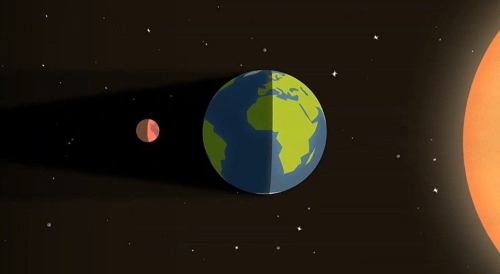
Source: NASA
Also Read| Snow Moon 2025: Date, Time and Significance of February's Full Moon
The Moon & Eclipses
Eclipses occur when the Earth, Moon, and Sun align in a way that casts a shadow on either the Moon or the Earth. These celestial events happen four to seven times a year due to the Moon’s tilted orbit. There are two main types of eclipses:
- Lunar Eclipse: Occurs when Earth's shadow obscures the Moon.
- Solar Eclipse: This happens when the Moon blocks the Sun from Earth's view.
The Moon’s Tilted Orbit
The Moon's orbit is tilted about 5 degrees compared to Earth's orbit around the Sun. This prevents monthly eclipses because the Moon usually passes above or below the Sun from Earth's perspective. Eclipses only occur when the Sun, Moon, and Earth align perfectly.
What is a Lunar Eclipse?
A lunar eclipse, a "Blood Moon" due to its reddish-orange appearance, takes place when the Earth comes between the Sun and the Moon, causing the Earth's shadow to fall on the Moon. A total lunar eclipse occurs when the Moon is completely enveloped by the Earth's umbra, which is the darkest part of its shadow.
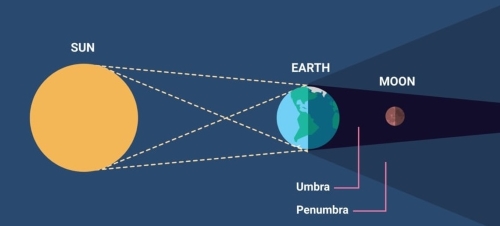
Source: timeanddate
There are three types of Lunar Eclipse:
1. Total Lunar Eclipse: This occurs when the Moon completely enters the Earth's umbra, which is the darkest part of its shadow. During this event, the Moon doesn't vanish from sight but instead takes on a reddish hue. This coloration is due to a phenomenon known as Rayleigh scattering. As sunlight passes through Earth's atmosphere, the shorter blue wavelengths are scattered away, while the longer red wavelengths are refracted (bent) towards the Moon. This effect is often referred to as the "Blood Moon."The intensity and shade of red can vary depending on the atmospheric conditions of the Earth at the time of the eclipse.
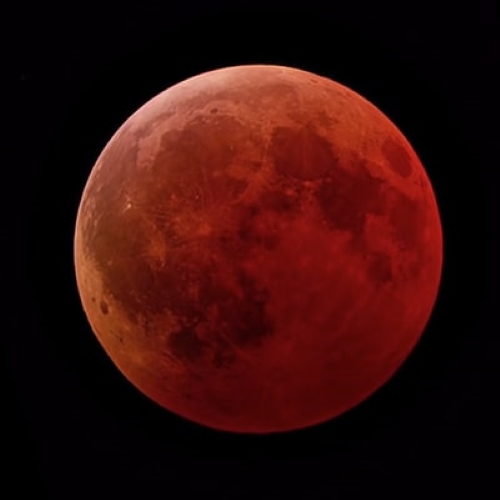
Source: NASA
2. Partial Lunar Eclipse: This occurs when only a portion of the Moon enters the Earth's umbra. During a partial lunar eclipse, a distinct dark shadow is visible on the lunar surface, while the rest of the Moon remains illuminated by sunlight. The extent of the shadow and the portion of the Moon affected depend on the alignment of the Sun, Earth, and Moon.
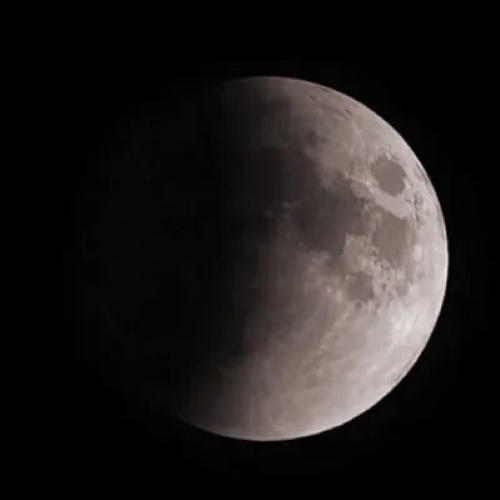
Source: NASA
3. Penumbral Lunar Eclipse: This occurs when the Moon passes through the Earth's penumbra, which is the outer, fainter part of its shadow. During a penumbral lunar eclipse, the Moon undergoes a subtle dimming, which can be challenging to observe with the naked eye. This type of eclipse is often less dramatic than total or partial lunar eclipses.
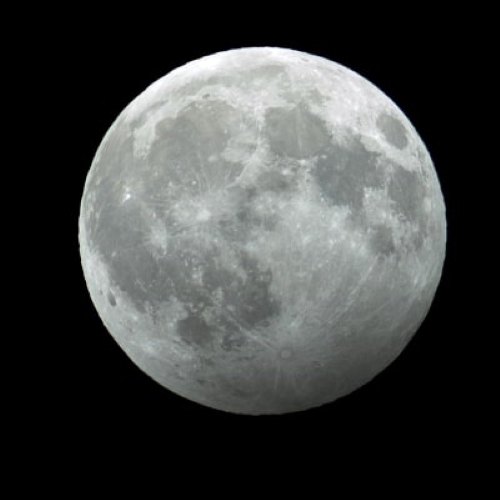
Source: NASA
| Key Points to Remember:
|
How to Observe the Eclipse
- No special equipment is needed – it is visible to the naked eye.
- Best viewing conditions: A dark location away from city lights.
- Use binoculars or a telescope for an enhanced view.
- Visibility Map: The March 2025 lunar eclipse will be visible across the Western Hemisphere.
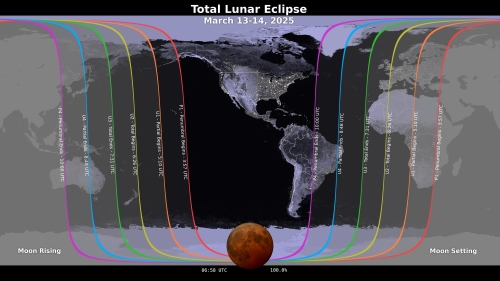
Source: NASA
Eclipse Timeline & Key Events
| Milestone | UTC Time | PDT Time | EDT Time | Description |
| Penumbral eclipse begins | 03:57 | 8:57 PM (Mar 13) | 11:57 PM (Mar 13) | The Moon enters Earth's faint outer shadow. Slight dimming occurs. |
| Partial eclipse begins | 05:09 | 10:09 PM | 1:09 AM | The Moon begins entering Earth's umbra, looking like a "bite" is taken out of it. |
| Totality begins | 06:26 | 11:26 PM | 2:26 AM | The Moon is fully within the umbra and turns red. |
| Totality ends | 07:31 | 12:31 AM | 3:31 AM | The Moon starts exiting the umbra. The red hue fades. |
| Partial eclipse ends | 08:47 | 1:47 AM | 4:47 AM | The Moon is mostly out of the umbra. |
| Penumbral eclipse ends | 10:00 | 3:00 AM | 6:00 AM | The eclipse is over. |
Why Does the Moon Turn Red?
As sunlight passes through Earth's atmosphere, shorter wavelengths (blue and green) scatter, leaving only longer wavelengths (red and orange) to reach the Moon. When the Earth is directly between the Sun and the Moon, this effect causes the Moon to appear red. The more dust or clouds in the atmosphere, the redder the Moon can appear, creating a stunning "Blood Moon."
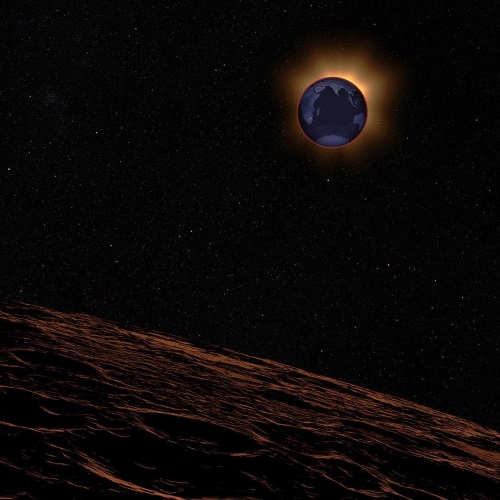
Source: NASA
- The red-orange hue occurs due to Rayleigh scattering, the same effect that makes sunsets red.
- Earth's atmosphere filters sunlight, allowing only longer wavelengths (red & orange) to reach the Moon.
- The more dust or clouds in Earth's atmosphere, the redder the Moon appears.
What Else Can You Observe on Eclipse Night?
During the lunar eclipse, several celestial objects will be visible in the sky. Many planets including Jupiter & Mars with Constellations and will enhance star visibility.
- Jupiter and Mars: Visible in the western sky.
- Constellations: The Moon will be in Leo at the beginning and will later cross into Virgo.
- Enhanced star visibility: As the Moon dims, fainter celestial objects become more prominent.
Eclipses and Spacecraft
Lunar eclipses offer unique observational opportunities, even though they generally have minimal impact on satellite operations, as satellites are equipped with batteries to store energy and function during periods of darkness. However, during lunar eclipses, NASA's Lunar Reconnaissance Orbiter (LRO) shuts down most of its instruments to conserve energy, as it is solar-powered and loses its power source during the eclipse. The Diviner instrument remains active, as it can observe how the lunar surface responds to the rapid temperature change caused by the eclipse. This data allows scientists to infer the size and density of rocks on the moon, and better understand the surface's composition and properties, as different rock sizes cool at different rates.
Future Changes in Eclipses
Scientists at NASA noted that:
- The Moon is drifting away from Earth at 1.5 inches (3.8 cm) per year.
- In 600 million years, the Moon will be too far to cause total solar eclipses, resulting only in annular eclipses.
Upcoming Lunar Eclipses
| Date | Eclipse Type | Visible Regions |
| March 14, 2025 | Total | Pacific, Americas, Western Europe, Western Africa |
| September 7, 2025 | Total | Europe, Africa, Asia, Australia |
| March 3, 2026 | Total | East Asia, Australia, Pacific, Americas |
| August 28, 2026 | Partial | East Pacific, Americas, Europe, Africa |
Click here to get detailed description on Upcoming Lunar Eclipses
Conclusion
The March 2025 Total Lunar Eclipse will be a spectacular celestial event visible across the Western Hemisphere. This is an excellent opportunity for stargazers, photographers, and astronomy enthusiasts to witness a breathtaking natural phenomenon. For the best experience, head to a dark location and use binoculars or a telescope to capture detailed views of the Moon's transformation.
Comments
All Comments (0)
Join the conversation